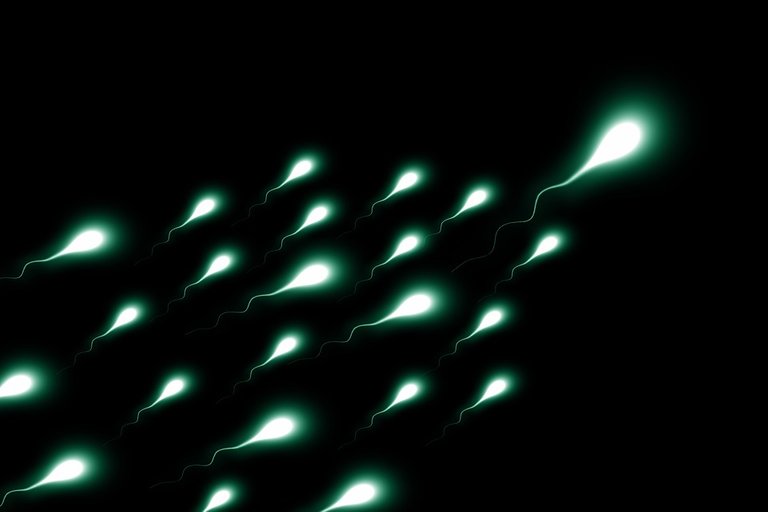
Sperm.
We all know what sperm is, right? And we know what happens when it fuses with the egg cell, right? Well, partly. You probably know all the blah about the sperm entering the egg cell, the DNA fusing and the cell then divides, over and over again, until we have a human.
But that’s only part of the story.
The DNA in sperm is very, very compressed, so it fits all in that tiny cell. A sperm cell doesn’t contain much aside from DNA, in contrary to an egg cell. Why should it? The egg cell provides anything it needs!
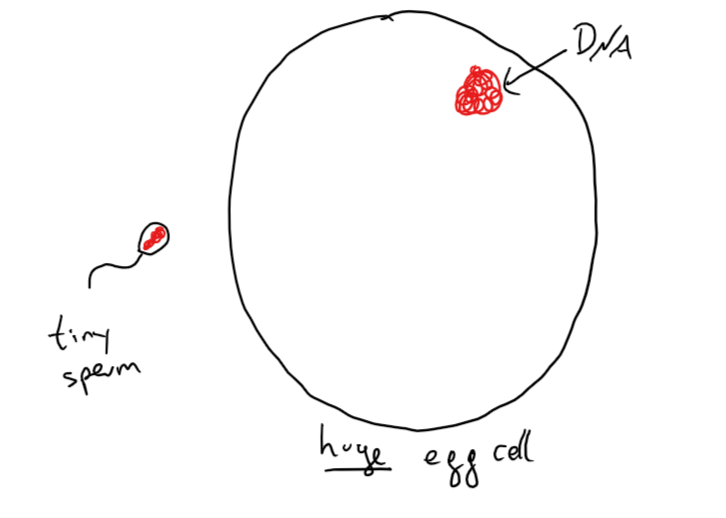
But as soon as it enters the egg cell, it needs to unpack and epigenetic adjustments have to be made.
Too fast? Let’s slow down.
Epigenetics
Genetics is what’s written in our genes, what can only be changed through mutation or artificial gene editing. But you’ve probably heard about things or behaviors having “an effect on your genetics”. That’s usually tied to epigenetics (epi = over/outside of/around).
There are two (technically three but the third caused a big argument in my lab so we’ll stick with two) epigenetic mechanisms.
- DNA modification
- Histone modification
Histones are the proteins which keep DNA tightly packaged, which is necessary because our DNA is really, really long. Histone modifications interact with DNA modifications in many ways, the two influence each other. It’s pretty complicated, especially if you have no background knowledge in genetics. So we’ll focus on something simpler. @suesa
DNA methylation is a modification of the DNA where a methyl group (that’s one carbon (C) atom and three hydrogen (H) atoms) is added to a specific part of the DNA (in eukaryotic cells, it’s added to the base cytosine. For those who don’t know what that “eukaryotic” or “cytosine” means: It’s not that important for what I want to tell you).
When a part of the DNA is methylated, the gene can’t be “read” and thus no protein for it can be produced. The gene is effectively “turned off”.
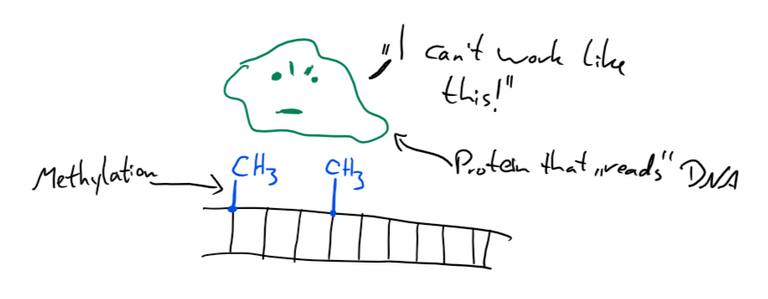
DNA Methylation in Mouse sperm
What I’m currently looking into is the development of mouse embryos (short version). The interesting part in this is what happens after the sperm has entered the egg cell and before the cell divides the first time. Because more things happen than you might think!
As I said earlier, the sperm DNA (I’ll call it “paternal” DNA from now on, the egg cell DNA will be the “maternal” DNA) is very tightly packed. But not just that! It has a very high amount of methylated Genes.
During the first few hours after fertilization, paternal and maternal DNA seem to “increase in size”, which is mostly due to the fact that they’re being “unpacked” (like a zip file!). The paternal DNA seems to increase a lot more, for some currently unknown reason.
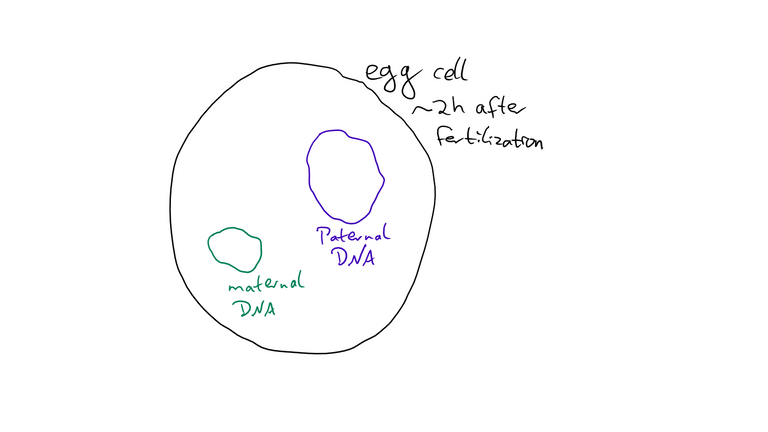
And something else happens.
While the amount of methylated genes in the maternal DNA stays roughly the same, the methylation of paternal genes … decreases! A lot!
Active and Passive Demethylation
There are several reasons why methylation can be lost.
When DNA is replicated, it happens semi-conservative. That means the double strand is separated and each half serves as a template for the new double strand. If only one of them carries the methylation, only one of the new strands will have that too. The effect is basically a “dilution” and called “passive demethylation”.
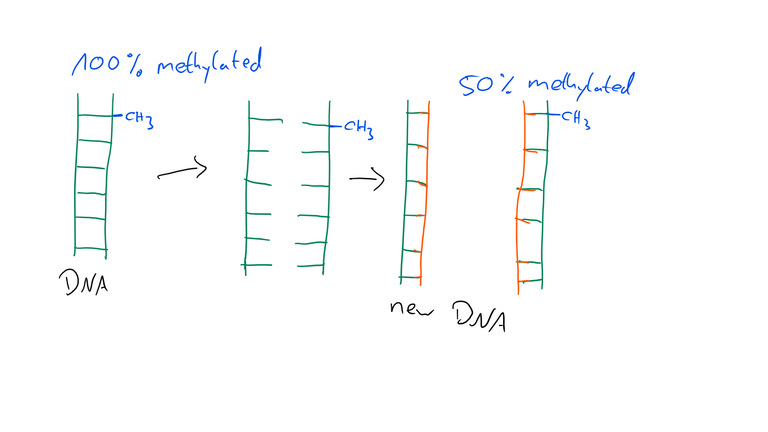
That one can’t be the reason tho, as the demethylation happens before the cell divides and before the DNA is replicated.
Active demethylation requires, as the name indicates, an active removal of the methyl group. But that requires energy, a lot of energy. And specialized enzymes. And the demethylation doesn’t exactly happen without any side effects, no. The process causes significant damage to the DNA, which has to be repaired.
There have been experiments that have shown that active demethylation really happens, which means the paternal DNA is repeatedly cut and repaired. But it still doesn’t account for the sheer mass of changes.
The Joys of Oxidation
Wikipedia defines oxidation as
a chemical reaction in which the oxidation states of atoms are changed.
That’s a super useless explanation for everyone who didn’t take chemistry in high school or college/university. What oxidation often means in biology is
we just added an oxygen atom.
That’s a bit easier to understand, isn’t it? And of course, that’s technically what happens to the methyl groups.
Through the influence of a certain enzyme, this

Turns into this

Which can be oxidized again … and again. You get the gist. Important thing is, this oxidation is enough to make the methyl group seem to “disappear” when you measure it with the help of fluorescent antibodies (what’s that? Something cool I might explain another time).
Now, the question is: Why does this happen only to the paternal DNA, not the maternal? Why does it happen at all? What happens if we manage to turn it off? Or only partly off?
That’s research which is currently happening, and in which I’ll be taking part.
Closing Words
I hope you were able to understand/learn something from this post, even if it’s just “Wow, genetics and epigenetics are nuts, what the fuck” because that’s already something.
I won’t act like it’s super easy to understand, it’s a complicated subject and it was less than easy for me to break it down in under 1000 words. But it’s what I’m working on at the moment and I enjoy sharing it.
I plan on doing that more frequently from now on, break down some parts of what I’m working with (which is A LOT!).
Ask if you want to know more 😊
Sources:
5-Hydroxymethylcytosine in the mammalian zygote is linked with epigenetic reprogramming
Active demethylation in mouse zygotes involves cytosine deamination and base excision repair
Dynamic link of DNA demethylation, DNA strand breaks and repair in mouse zygotes.
Pictures, if not indicated differently, made by me

Good work, thanks for adding to my knowledge. I am curious, where does the oxygen/electron for demethylation of the sperm's DNA come from?
Good question, I can't give a definite answer to that. There are a lot of things going on in that egg cell, guess something provides oxygen.
Oxygen I abundant in the cell. The energy comes from the maternal gamete.
Energy deficit in the maternal gamete is actually a common reason for miscarriages.
Perhaps i will also try and reseach about it.
The sneaky sperm cells all come like a thief; packed with all the tools of its trade carefully well hidden. Once inside the house or egg, it brings out all the tools (unzips if you will) and starts work.
Above is exactly what was going through my mind as I read this post. Now I know it is not only .rar and .zip files that are compressed :)
zip, unzip, sperm, egg......... everything is already adding up :)
It wasn't clear if it was before the sperm and egg pronuclei fuse or it after the pronuclei fuse to form the one cell zygote?
Cheers!
Ian@suesa can you clarify this sentence "During the first few hours after fertilization, paternal and maternal DNA seem to “increase in size”"
It's before the pronuclei fuse :) when I was talking about "paternal and maternal DNA" what I meant was "pronuclei". But when writing a post for non-scientists, I try to keep the amount of scientific words low.
Cheers!Thanks for the clarification, that is what I had thought. Here is a link to an interesting article on hydroxymethylation and how it regulates retinal neurogenesis in a cell non-autonomous way by regulating Wnt and Notch pathways in zebrafish. You may have already seen it, but thought it may provide some mechanistic insight to what is going on with the paternal DNA during fertilization. https://www.ncbi.nlm.nih.gov/pubmed/28926578
Thanks!
Awesome post as usual, thanks for the fun read. Looks like some cool research and definitely something we'll have to understand before we get to "GATACA" levels of engineering our genomes.
It also reminded me of an autism-like condition I learned about last year called Angelman syndrome. It's caused by a mutation in the maternal copy of a specific gene (UBE3A) because the paternal copy of the gene is selectively methylated and never expressed in neurological development.
This imprinting is more prominent in the limbic system and the cerebellum, centres responsible for emotion responses and complex motor movements. Consiquently these are often the deficits we see in individuals with Angelman syndrome. It's so called because a hallmark of the disease is a happy disposition.
This video is a really good intro (and super upbeat :D)
ahh this reminds me of my old biology course. nice to see some science here in steem :)
Waoh. I never really thought about this before, now I have learnt a new thing. Thanks for sharing
I do not understand much from the language of biology, but you are very clear. Explanatory words. Thank you. .
You just made me regret not taking the molecular and cell biology I was suppose to take last semester, I know a little about DNA modification though they are covalent modifications of the DNA bases but What I learnt was it was an exhaustive methylation of the cytosine. True?
But it was basically about modified bacteria DNA since am a microbiologist. Whose main purpose is to defend the genome against bacteriophages
Thanks for the knowledge
Bacteria can also methylate adenine and have a different way of methylating cytosine.
Thanks for this.. Does it have a specific position it binds to??
Actually, yes! And that's different for eukaryotes/prokaryotes too!
Found some interesting paper about methylation, if you're interested https://www.ncbi.nlm.nih.gov/pmc/articles/PMC3174260/
Thanks alot
This made me laugh harder than it should have :D
But it is so true.
Anyway, your breakdown of your work is an interesting read and you definitely have the ability to explain it in a way, even non-professionals can get it.
And your painting skills are truly amazing :)
I guess art is my one true talent :P
Thank you. I've learned a lot from your interesting post. Very pedagogically presented. Still, I must admit this is rather complex material for a social science researcher :)
I think, no matter what our field is, we should always strive to read something from a different field now and then. The problem with this is just that most interesting things are written in such horribly complicated ways, that you just can't understand them without the right background. It's sad.
HA! You summed up my life! I tried doing exactly that for SteemStem, and you guys have been awesome :D
Let's get science out there!
Yay! Science!
Fascinating! I hope to see from you a whole series of posts on this topic. IIUC this demethylation that affects paternal DNA so much is only a type of DNA modification, so we haven't even gotten to histone modification yet. If you need 1500 or 2000 words on occasion to cover more of this, I for one would be fine with that. Cheers!
I wonder if sexual asymmetry in demethylation is a mammal thing, a vertebrate thing, an animal thing — or if non-animal organisms with sexual reproduction also have the same thing happening?
I think one of the papers specifically said "mammal", but I can't be 100% sure if it's really the only case.
Ok I might have understood something here. Or not. But still was interesting!
Hey did you hear they were trying to actually generate spermatozoids in labs as we are speaking? That's scary/fucked up/cool all at the same time!
Sounds super cool :D
https://www.newscientist.com/article/2105520-human-sperm-grown-in-a-lab-for-the-first-time-claims-study/
We didn't learn about this while I was a student :(
Thanks for the update
Grampy protein on your sketch, LOL :)
It's relatively recent research, so no wonder :P
I've just started to try and knock out a gene that is responsible for the oxidation. Fascinating stuff, and I get to work with crispr!
Once more one must be amazed how your paint skills deliver each and every time.
t.
Thanks for making me think! Interesting stuff. When I read this it made me realize how much we still have to learn in virtually all areas. A vast frontier ahead!
Nice job explaining epigenetics. I worked in a Nutrition and Genetics lab for several years and we worked with mice. We always looked at the methylation levels on liver and in sperm via pyrosequencing methods. Our lab was curious about cross-generational epigenetic inheritance. I had a meager Associates degree in Biotech and it took a good bit of studying before I understood the chemistry and science behind methylation and epigenetic inheritance. The fact I could read and understand your article means I actually retained some useful knowledge. Thanks for sharing!
Hello @suesa
Today I learnt that sperms DNA is compressed to fit in within the structure. And that sperm doesn't need to carry much nutrients into an egg. As the egg have adequate nutrients to support fertilization and further biological processes.
Thanks for sharing
@eurogee
Really interesting and helpful information about sperm, egg and DNA. As u said and mention in picture in egg dna has a small space in it. Is it same in sperm's DNA?
Mostly people relate these things only for sex and child. But i think its a science and we have to learn about it and want to know more inside hidden science with time.
nice to know Doc:)!
nice post
thanks for sharing
following you :)
Informative. Thanks @suesa
I am science student...i know much about sperm cell....it has
Flagellum
Acrosome
Nucleus
Mitochondria...
Those are the four parts of a sperm cell...
Robert hooke discovered sperm cell....nice post and discovery...bravo
Well it is very nice of you to share your work with us. Its always a time to learn something new.
I thought i would know how my dad did it after reading. 😁
Sorry, for sex ed you need to check @julienbh :P
I am student of Molecular biology,So this is very informative for me,well done.Research is always hard work and great work.
Keep it up
Its really nice to read your entry, i learned a lot.
Thank you for sharing this.
I can't stop reading this over and over again. Life is the grates riddle. It's not silly some call it a miracle, when you don't know how it is made. Just like people in novel "100 Years of Solitude" used to call "marvel" everything new gypsies were bringing to little village of Macondo, like magnet or so. :)
Man created by God from everything created from male sperm and female ovum
great post @suesa
a compressed file that loses half of its contents. Thanks for sharing, I follow you.
It is difficult to create an article that's informative and entertaining.
You nailed it. Absolutely.
My admiration, respect, and thanks for an excellent post.
@suesa : When I switched to computational biology, one of the most exciting thing I noticed about the sperm was it's molecular motor mechanism. Until that point, I never thought these were "machines". Cool machines. One another fact which I recently learned about these "vehicles" were that their laws of motions are Aristotelian in nature instead of Newtonian(because of the friction/drag thing. Water for these micro things are like dense fluid). Force is approximately propotional to velocity instead of acceleration!! It is awesome! You are lucky in the sense that since you work in a wetlab. Yeah I know it is challenging too. :)
very basic biology of sperm yet not everyone knows how complex it really is. thanks for breaking it down for us @suesa :)
Cool to read about.
Like the science #.
Always good to start your day with some brain building.
Will be carefull with my sperms from now on.
Hi @suesa I think DNA is a molecules in the living cell and I think it contain information from your parents ( father and Mother) that determine how your growth will be. may be not exactly this is only my opinion and its great subject that you are sharing here. Thanks a lot
I wonder of the increased expression of the paternal DNA has to do with the fact that it is "new" DNA to the cell.
In a sense, the egg is accepting the paternal DNA we need to make sure that there is no autoimmune reaction so potentially it has to do with marking the DNA "Self."
congenial & fantastic!
@pwangdu your comment is considered spam and spam is a fancy word for harassment and/or aggrandizement. Very few of us like it. Spam diminishes the overall quality and authenticity of our Steem neighborhood. @steemflagrewards
Read this to unlock your true creative potential: https://steemit.com/steemcleaners/@steemcleaners/abuse-guide-2017-update
Great comment i love it